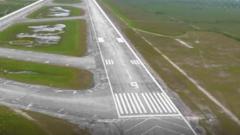A proposed facility hints at larger implications for immigration policies while local communities advocate against its construction.
**Florida's Controversial 'Alligator Alcatraz': New Migrant Detention Center Under Fire**

**Florida's Controversial 'Alligator Alcatraz': New Migrant Detention Center Under Fire**
The recent transformation of an abandoned airport in the Everglades into a migrant detention facility sparks environmental and human rights concerns.
In a bold move to bolster immigration enforcement, Florida has embarked on a controversial project turning a near-abandoned airport in the Everglades into a detention facility for migrants, nicknamed "Alligator Alcatraz." This undertaking, launched with a convoy of trucks delivering materials to the Dade-Collier Training and Transition Airport, aims to support the federal deportation agenda championed by former President Donald Trump.
State officials assert that the facility will serve as an innovative, cost-effective solution for handling undocumented immigrants. "If individuals escape, the only thing they'll encounter is the surrounding swamps inhabited by alligators and pythons," remarked Florida's attorney general, James Uthmeier, in a spirited promotional video.
Located approximately 43 miles from Miami, the airstrip currently functions primarily as a pilot training runway, positioned amidst ecologically significant wetlands. Conditions are daunting, with dense summer heat and abundant mosquitoes. Attempts to approach the construction zone were met with barriers, leaving curious observers to ponder the local wildlife—alligators or perhaps snakes—as they sought answers about the emerging site.
Following a 2023 executive order from Governor Ron DeSantis, which triggered emergency measures to address migrant surges, this new facility is projected to house up to 1,000 detainees by its anticipated opening date in July or August. DeSantis further possible plans to expand similar facilities, hinting at operations at another military site.
The decision to create “Alligator Alcatraz” stands as a glaring symbol of the ongoing tensions surrounding U.S. immigration policy, particularly amid reports of overcrowding in existing facilities. The Immigration and Customs Enforcement (ICE) currently grapples with a detainee population that exceeds 59,000—140% above capacity.
Local residents express growing fears about the environmental impact of the proposed facility. Betty Osceola from the Miccosukee Tribe participated in a protest emphasizing potential harm to the delicate ecosystem, voicing deeper worries about the conditions migrants could face within the facility.
As human rights organizations like the ACLU of Florida raise alarm over the treatment and living conditions anticipated at the center, local government officials are also beginning to question its feasibility. Miami-Dade Mayor Daniella Levine Cava has sought further clarity regarding state plans for the facility, particularly its ecological ramifications.
Despite rising opposition from both environmental and civil rights advocates, Uthmeier continues to portray the endeavor favorably, calling it a "low-cost” opportunity to detain undocumented individuals efficiently. His remarks reflect a broader commitment at the federal level to expedite efforts to deport migrants deemed illegal.
As the construction of "Alligator Alcatraz" unfolds, advocates vow to monitor developments closely. The unfolding narrative poses essential questions about both the future of U.S. immigration enforcement and the integrity of vulnerable ecosystems within the Everglades.
State officials assert that the facility will serve as an innovative, cost-effective solution for handling undocumented immigrants. "If individuals escape, the only thing they'll encounter is the surrounding swamps inhabited by alligators and pythons," remarked Florida's attorney general, James Uthmeier, in a spirited promotional video.
Located approximately 43 miles from Miami, the airstrip currently functions primarily as a pilot training runway, positioned amidst ecologically significant wetlands. Conditions are daunting, with dense summer heat and abundant mosquitoes. Attempts to approach the construction zone were met with barriers, leaving curious observers to ponder the local wildlife—alligators or perhaps snakes—as they sought answers about the emerging site.
Following a 2023 executive order from Governor Ron DeSantis, which triggered emergency measures to address migrant surges, this new facility is projected to house up to 1,000 detainees by its anticipated opening date in July or August. DeSantis further possible plans to expand similar facilities, hinting at operations at another military site.
The decision to create “Alligator Alcatraz” stands as a glaring symbol of the ongoing tensions surrounding U.S. immigration policy, particularly amid reports of overcrowding in existing facilities. The Immigration and Customs Enforcement (ICE) currently grapples with a detainee population that exceeds 59,000—140% above capacity.
Local residents express growing fears about the environmental impact of the proposed facility. Betty Osceola from the Miccosukee Tribe participated in a protest emphasizing potential harm to the delicate ecosystem, voicing deeper worries about the conditions migrants could face within the facility.
As human rights organizations like the ACLU of Florida raise alarm over the treatment and living conditions anticipated at the center, local government officials are also beginning to question its feasibility. Miami-Dade Mayor Daniella Levine Cava has sought further clarity regarding state plans for the facility, particularly its ecological ramifications.
Despite rising opposition from both environmental and civil rights advocates, Uthmeier continues to portray the endeavor favorably, calling it a "low-cost” opportunity to detain undocumented individuals efficiently. His remarks reflect a broader commitment at the federal level to expedite efforts to deport migrants deemed illegal.
As the construction of "Alligator Alcatraz" unfolds, advocates vow to monitor developments closely. The unfolding narrative poses essential questions about both the future of U.S. immigration enforcement and the integrity of vulnerable ecosystems within the Everglades.























